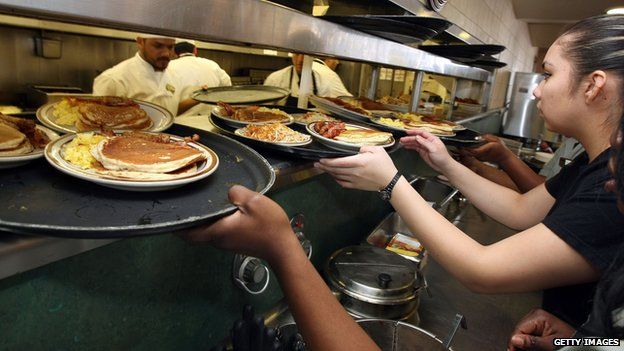US grows at annual rate of 3.5% in third quarter
- Published

The US economy grew at an annual rate of 3.5% in the July-September quarter, the Commerce Department has said.
That was better than the 3% pace that economists had been expecting and follows the 4.6% growth rate recorded in the April-June quarter.
Strong export growth and higher government spending helped to boost growth in the third quarter.
In a sign of confidence in the US recovery, on Wednesday the Federal Reserve ended its stimulus scheme.
The fall in the unemployment rate to a six-year low has helped to boost that confidence.
"Today's number represents a return to a healthy-looking trend. The most recent IMF forecasts suggest the US economy will grow 3.1% next year and 3.0% in 2016, and these could be revised further upwards in the coming months," said Ben Brettell, senior economist at Hargreaves Lansdown stockbrokers.
The report was the first of three estimates of gross domestic product, so the figure could be revised up or down, over the coming months.
Growth was lifted in the third quarter by a sharp increase in government spending, which itself was boosted by a surge in defence expenditure.
Consumer spending
Exports were another area of strength, they rose at an annual rate of 7.8%.
But there will be a question over whether that pace can be maintained as important export markets for the US are struggling.
Growth in many European countries is stagnant and the Chinese economy is slowing down.
Consumption growth was relatively weak in the third quarter, running at an annual rate of 1.8%, but economists expect that to improve.
"Conditions are in place for a pick-up in the pace of consumption growth," said Paul Ashworth, chief US economist at Capital Economics.
"Real personal disposable incomes increased by a healthy 2.7% in the third quarter and, with the prospect of further big gains in employment and the impact of the slump in energy prices, real incomes should enjoy an even bigger gain in the fourth quarter."
Overall it has been a volatile year for US growth data.
In the first quarter the economy contracted at an annual rate of 2.1% after severe weather hampered economic activity.
But the second quarter saw a rebound, growing at an annual pace of 4.6%.
Taken together the latest two quarters are the strongest consecutive quarters of growth since the second half of 2003.
Stimulus over
On Wednesday the US Federal Reserve announced the end of its quantitative easing (QE) stimulus programme.
QE started in November 2008 amid the financial crisis and fears that the US, and the rest of the world, might be facing another great depression.
Since then the Fed has bought $3.5 trillion of US government debt and bonds created out of home loans or mortgages.
It began to phase out the scheme last year and a fall in unemployment to 5.9% has encouraged the Fed to end it altogether.
However, interest rates will remain at a record low for a "considerable time" according to the US central bank.
- Published3 October 2014
- Published29 October 2014
- Published29 October 2014